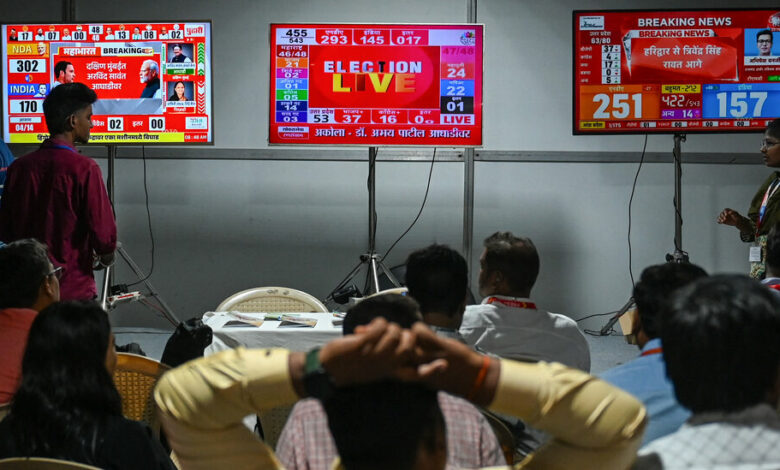India’s Cable News predicted a big Modi victory. How could they be so wrong?

During the months of India’s national election campaign, the country’s hundreds of cable news channels all seemed to be trying to outdo each other: predicting that Prime Minister Narendra Modi would win, and by a wide margin.
However, the election results of June 4 reduced his chances to such an extent that he could only secure a new term with the help of his coalition partners.
It was a shocking result for many, and now India is wondering why so few foresaw the popularity of an opposition movement. Some media had predicted that Modi’s Bharatiya Janata Party (BJP) would win as many as 400 of the 543 available seats in parliament, but it ended up winning only 240.
Many see these differences as a sign of how much the prime minister has intimidated the mainstream media and how his control over the information system has become so great that hype obscures the true feelings of voters.
During Modi’s decade in power, a mix of pressures and incentives turned mainstream news outlets into cheerleaders for his every move. They presented the powerful prime minister as an unstoppable leader, too overwhelming for any opponent to challenge. Debating him on policy, or even on his delivery on his promises, was out of the question.
Many reporters at mainstream news organizations embraced what Modi had normalized: pride in his Hindu vision of India. Those who investigated the unsavory side of his tenure, including independent bodies Those who sharply criticized his policies were excluded, ambushed, or otherwise forced to surrender.
When the exit polls came out on election night, one channel even declared that Modi’s alliance would win 30 parliamentary seats in a state that had only 25. Another presenter appeared to ridicule his own network’s reporters for suggesting there was discontent over the economic stress.
Analysts said the fact that the vast majority of media outlets were way off in their predictions indicated two things: Indian citizens were either too afraid to express their opinions, or they were too distrustful of the broadcast media to give them their real opinions.
“The media was actually campaigning for the ruling party,” said Yogendra Yadav, a political activist and veteran election analyst, adding: “They are a blot on our democracy.”
Mr. Modi and the mainstream media have underestimated how much of the information space has moved outside the bubble they created, analysts say. Now that the mainstream media has lost credibility, a parallel system of online news the number of reporters with a more independent perspective has grown.
In fact, much of the election was played out on the internet. Opposition leaders found online spaces important outlets for criticism of Mr Modi, who they say has made India less democratic and more unequal.
“Centriste journalism is missing and that is a loss for this country,” said Saurabh Shukla, co-founder of The Red Mike, a YouTube channel.
Mr Shukla, an award-winning reporter who quit his job at a news channel to start a YouTube channel with another journalist, said there was a stark contrast between what was shown on TV news and what he and many other journalists saw on the ground.
In a sign that even Mr Modi was waking up to the inequality, he sent his ministers to talk about his party’s performance on YouTube channels. At times, he even trolled the mainstream media that praised him.
“If you are in the media and if you wave a Modi flag out of respect, who will stop you?” the prime minister told four interviewers from a media organisation in New Delhi.
With a population of 1.4 billion, India has over 350 news channels spread across 880 satellite TV channels. It also has the largest number of YouTube users in the world.
Since independence in 1947, India has built a reputation as a country with a large and independently oriented media culture. This reputation was only marred by the months-long state of emergency and censorship imposed by Prime Minister Indira Gandhi in the mid-1970s.
That independent stance has been changing over the course of Modi’s leadership, however, as leaders in his Hindu nationalist bloc have found numerous ways to exert pressure to keep media groups in line.
Reporters and editors critical of the government began to leave traditional news channels and move online one after another. Unlike television news channels that devoted hours to Mr. Modi during the campaign period, this group of independent reporters talked about people, their stories and their problems.
Among them is Ravish Kumar. After quitting his job as a primetime news anchor, Mr. Kumar started to broadcast on YouTube. For months, he has focused on issues such as rising rural unemployment and loopholes in competitive exams, which have led hundreds of thousands of students to join protest marches.
While Mr Kumar, watched by more than a million people almost every day, questioned Mr Modi about using religious polarisation to win votes instead of talking about his development record, his TV news colleagues used prime time to attack Mr Modi’s opponents.
The network news anchors used their interview time with Modi mostly to ask bland questions that had nothing to do with national issues, such as, “Are these elections a formality?” or “Why don’t you get tired?”
Another independent journalist, Ajit Anjumreported voter anger at a federal minister after he spent money to dawn in the chief ministerial constituency in the state of Uttar Pradesh. Many news channels predicted her to win by a landslide, but she was defeated by her modest rival, a long-time campaign manager for opposition leaders. It was another accurate prediction by an independent YouTube news channel.
“YouTube has made it difficult for the BJP and its media supporters,” said journalist Shukla. As more election results came out, a growing number of viewers seemed to be turning to online news viewers for follow-up coverage.
Various independent media organisations came together for their own election night reporting. Moreover, many Indians followed them online, for analysis that was more down-to-earth than the shouting matches on TV news.
It is unclear whether the sudden surge in independent journalism will last.
“I don’t know if this will continue,” said Mandeep Punya, a freelance journalist, adding that while more people are viewing his content, a new law has made it easier for the government to censor online stories.
Despite the challenges posed by government, online news providers earned an edge in reliability this election cycle. Their accuracy in predicting outcomes stood in stark contrast to how cable news networks’ forecasts performed.
Mr. Yadav, the political activist, said after a trip to India’s Hindi-speaking north, home to Mr. Modi’s party’s traditional base, that he expected the BJP to win no more than 260 seats. Few believed his estimate, especially among television news commentators. But he was right.




